May brings the anticipation of celestial events, making it the perfect time to consider enhancing your view of the cosmos. A quality star watching telescope can transform your experience of the night sky, from observing the details of the upcoming Flower Moon on May 12 to identifying the distinct colors of stars like the blue-white stars of the Summer Triangle, the orange hue of Arcturus, or the reddish glow of Antares. For enthusiasts tracking planetary movements, a good star watching telescope is essential to appreciate sights like Saturn’s pre-dawn appearances, including its conjunction with the crescent moon on May 22.
Choosing the right star watching telescope, especially your first one, can feel overwhelming given the vast array of options. Our comprehensive guide simplifies this process by covering various budgets, skill levels, and purposes. We provide hands-on reviews from experts, rigorously testing observational capabilities, ease-of-use, and overall performance to help you select the perfect star watching telescope for your astronomical journey. Whether you’re a beginner seeking a user-friendly model or an experienced astronomer looking for advanced features, there’s a star watching telescope tailored to your needs, opening up incredible views of the universe. Getting started with an amatuer telescope or a hobby telescope can be a rewarding experience.
Jump to:
The Quick List of Best Star Watching Telescopes
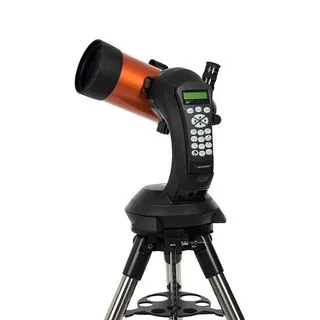 Celestron NexStar 4SE star watching telescope on a white backgroundBest Star Watching Telescope for Beginners
Celestron NexStar 4SE star watching telescope on a white backgroundBest Star Watching Telescope for Beginners
Celestron NexStar 4SE
Best for beginners
An excellent star watching telescope for newcomers, the Celestron NexStar 4SE is user-friendly, simple to set up, provides sharp and bright images, and includes numerous helpful features.
 Celestron Inspire 100AZ star watching telescope on a white backgroundBest Budget Star Watching Telescope
Celestron Inspire 100AZ star watching telescope on a white backgroundBest Budget Star Watching Telescope
Celestron Inspire 100AZ
Best budget telescope
The Celestron Inspire 100AZ is a fantastic star watching telescope option for beginners just starting out in astronomy, coming complete with a variety of useful accessories.
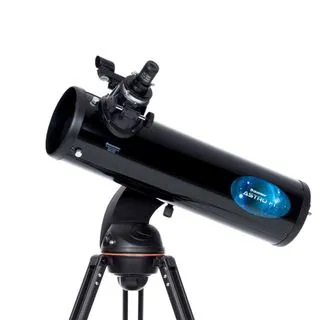 Celestron Astro Fi 130 star watching telescope on a white backgroundBest Value Star Watching Telescope for Enthusiasts
Celestron Astro Fi 130 star watching telescope on a white backgroundBest Value Star Watching Telescope for Enthusiasts
Celestron Astro Fi 130
Best value for enthusiasts
We were thoroughly impressed with the Celestron Astro Fi 130 during our review, finding it to be an exceptional value as a star watching telescope.
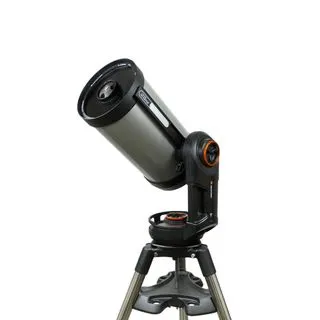 Celestron NexStar Evolution 9.25 star watching telescope on a white backgroundBest Premium Star Watching Telescope
Celestron NexStar Evolution 9.25 star watching telescope on a white backgroundBest Premium Star Watching Telescope
Celestron NexStar Evolution 9.25
Best premium
Considered an exceptional star watching telescope, it is easy to set up and provides breath-taking views. It is also well-suited for experienced astronomers.
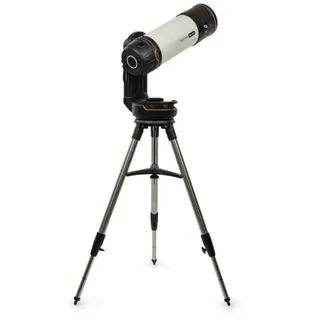 Celestron Origin Intelligent Home Observatory star watching telescope on a tripod on a white backgroundBest Star Watching Telescope for Astrophotography
Celestron Origin Intelligent Home Observatory star watching telescope on a tripod on a white backgroundBest Star Watching Telescope for Astrophotography
Celestron Origin Intelligent Home Observatory
Best for astrophotography
This smart star watching telescope captures beautiful deep sky photos in mere seconds, though it is not designed as a universal telescope for all observational purposes.
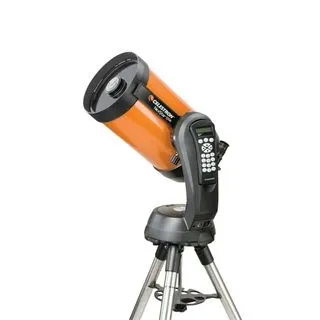 Celestron NexStar 8SE motorized star watching telescope on a white backgroundBest Motorized Star Watching Telescope
Celestron NexStar 8SE motorized star watching telescope on a white backgroundBest Motorized Star Watching Telescope
Celestron NexStar 8SE
Best motorized telescope
A fantastic star watching telescope for all experience levels, it is incredibly easy to use yet powerful enough for deep space exploration and suitable for astrophotography.
Load the next 5 products ↴
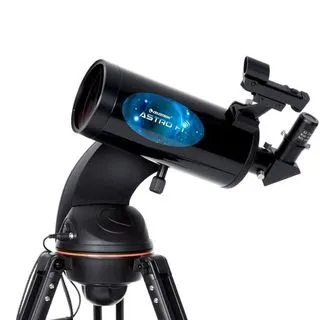 Celestron Astro Fi 102 portable star watching telescope on a white backgroundBest Portable Star Watching Telescope
Celestron Astro Fi 102 portable star watching telescope on a white backgroundBest Portable Star Watching Telescope
Celestron Astro Fi 102
Best for portability
If you reside in an urban area with significant light pollution and require a star watching telescope that is easily transportable to darker locations, this could be the ideal choice for you.
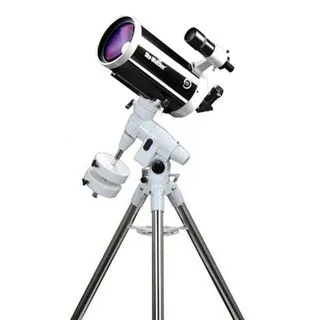 Sky-Watcher Skymax 150 PRO star watching telescope with accessories on a white backgroundBest Star Watching Telescope for Accessories
Sky-Watcher Skymax 150 PRO star watching telescope with accessories on a white backgroundBest Star Watching Telescope for Accessories
Sky-Watcher Skymax 150 PRO
Best for accessories
This star watching telescope is capable of capturing everything from nebulas to galaxies. It features outstanding optical quality free from distortion and can accommodate numerous accessories.
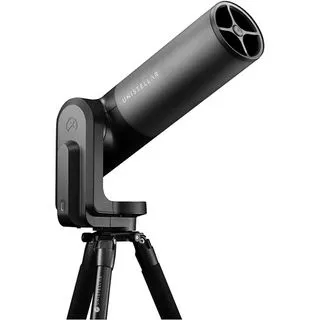 Unistellar eQuinox 2 Smart Star Watching TelescopeBest Smart Star Watching Telescope
Unistellar eQuinox 2 Smart Star Watching TelescopeBest Smart Star Watching Telescope
Unistellar Equinox 2
Best smart telescope
If your budget allows, this represents Unistellar’s most advanced star watching telescope to date. It boasts a highly reliable app and a Smart Light Reduction feature designed to eliminate light pollution in urban environments.
 Celestron Advanced VX 8 EdgeHD Schmidt-Cassegrain star watching telescopeBest Star Watching Telescope for Deep Space
Celestron Advanced VX 8 EdgeHD Schmidt-Cassegrain star watching telescopeBest Star Watching Telescope for Deep Space
Celestron Advanced VX 8 EdgeHD
Best for deep space
Excellent for experienced, long-time astronomers, this star watching telescope is superb for astrophotography thanks to its Edge HD technology. While slightly heavy, it can support a load up to 30 lbs.
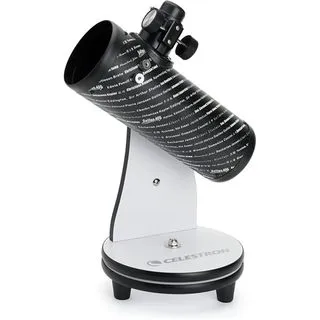 Celestron Classic Firstscope 76mm Tabletop star watching telescopeBest Star Watching Telescope for Kids
Celestron Classic Firstscope 76mm Tabletop star watching telescopeBest Star Watching Telescope for Kids
Celestron FirstScope 76 Tabletop telescope
Best for kids
This tabletop star watching telescope is an excellent starting point for beginners and young astronomers. It’s easy to set up and pack away, though it is not the most powerful option.
Best Star Watching Telescopes 2025 We Recommend
Our expert reviewers dedicate countless hours to testing and comparing telescopes and related products and services to help you make the best choice. Learn more about our product testing and review process.
Celestron NexStar 4SE – Best Star Watching Telescope for Beginners
Image 1 of 7
 The celestron nexstar 4se star watching telescope set up outside in a field at sunset
The celestron nexstar 4se star watching telescope set up outside in a field at sunset
In our comprehensive review of the Nexstar 4SE, we found its quick and easy setup ideal for beginners seeking a quality GoTo star watching telescope. (Image credit: Jonathan Lansley-Gordon)
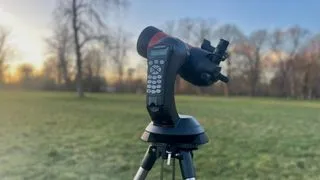 The celestron nexstar 4se star watching telescope set up outside in a field facing away from the camera
The celestron nexstar 4se star watching telescope set up outside in a field facing away from the camera
The Celestron NexStar 4SE’s GoTo technology facilitates easy identification and tracking of specific celestial objects for your star watching session. (Image credit: Jonathan Lansley-Gordon)
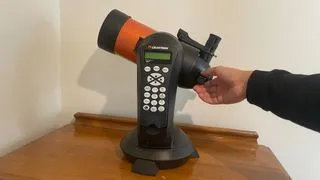 A view of the NexStar 4SE hand controller
A view of the NexStar 4SE hand controller
This star watching telescope will fit comfortably on your tabletop. (Image credit: Jonathan Lansley-Gordon)
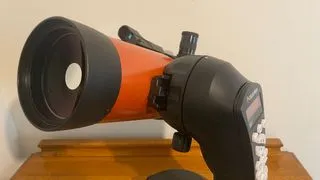 A close up view of the fork arm mount of the NexStar 4SE star watching telescope
A close up view of the fork arm mount of the NexStar 4SE star watching telescope
The NexStar 4SE features a 4-inch (102mm) aperture and a focal length of 1325mm, well-suited for many star watching tasks. (Image credit: Jonathan Lansley-Gordon)
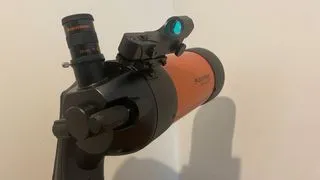 A close up of the finderscope on the NexStar 4SE star watching telescope
A close up of the finderscope on the NexStar 4SE star watching telescope
The 4SE has a built-in star diagonal operated by a flip mirror at its base. (Image credit: Jonathan Lansley-Gordon)
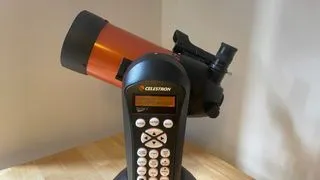 A side view of the Celestron NexStar 4SE star watching telescope on a wooden table
A side view of the Celestron NexStar 4SE star watching telescope on a wooden table
Celestron’s signature orange tube design is certainly distinctive for a star watching telescope. (Image credit: Jonathan Lansley-Gordon)
 Author operating the Celestron NexStar 4SE star watching telescope in the backyard
Author operating the Celestron NexStar 4SE star watching telescope in the backyard
Setting up the Celestron 4SE is straightforward, though despite the compact tube, transporting it was cumbersome on foot. (Image credit: Jonathan Lansley-Gordon)
Best for finding planets: It can easily locate celestial objects using Celestron’s SkyAlign technology.
Our expert review:
Specifications
Optical design: Maksutov-Cassegrain
Mount type: Computerized Alt-Azimuth
Aperture: 4-inches / 102mm
Focal length: 1325mm
Highest useful magnification: 241x
Lowest useful magnification: 15x
Supplied eyepieces: 25mm
Weight: 23 lbs (10.44kg) fully assembled
Reasons to buy
+Simple, quick setup
+Automatically finds night sky objects
+High-quality, durable construction
+No collimation required
Reasons to avoid
-Narrow field of view
-Not very portable
-Limited supplied accessories
Buy it if:
✅ It’s your first star watching telescope: This scope is easy to use and set up, making it ideal for beginner astronomers.
✅ You want GoTo technology: You can effortlessly locate and track specific celestial objects with minimal or no prior knowledge.
Don’t buy it if:
❌ You plan to travel frequently with it: This star watching telescope is not the most portable due to its tripod not folding down completely.
The bottom line:
🔎 Celestron NexStar 4SE: If your goal is to quickly and easily view planets and bright objects in the sky, the Celestron NexStar 4SE is definitely up to the task. ★★★★
The Celestron NexStar 4SE stands out as a fantastic first star watching telescope for beginners, largely thanks to its fully computerized mount. Equipped with Celestron’s SkyAlign technology, it automatically identifies the current date, time, and your location, then finds various targets in the night sky with the push of a button. This feature significantly simplifies stargazing for newcomers.
This star watching telescope boasts a 4-inch (102mm) aperture and a focal length of 1,325mm, sufficient to deliver sharp views of planets and other bright celestial objects. However, this combination results in a relatively narrow 1.2-degree field of view. This means fitting larger deep sky objects into the view can be challenging. The NexStar 4SE includes a 25mm Plossl eyepiece, but we suggest acquiring an additional 32mm eyepiece and a Barlow lens to fully utilize its 241x highest useful magnification for improved star watching.
The design of this star watching telescope is very robust, contributing to its weight. At 23 lbs (10.4 kg), the NexStar 4SE isn’t the lightest option, nor is it the most portable, partly because its tripod doesn’t fold down completely.
Another point to note about this particular star watching telescope is its power consumption. The mount rapidly depletes the 8xAA batteries required, making an external power source a highly recommended alternative. Consequently, the NexStar 4SE is perhaps best suited for those who prefer to enjoy star watching from their backyard rather than transporting it frequently.
Swipe to scroll horizontally
| Attributes | Notes |
|---|---|
| Design | Solid and sturdy build, signature orange colors. |
| Performance | Excellent for observing the moon and planets. |
| Functionality | Alignment correction can be tricky. |
Celestron Inspire 100AZ Refractor – Best Budget Star Watching Telescope
Image 1 of 7
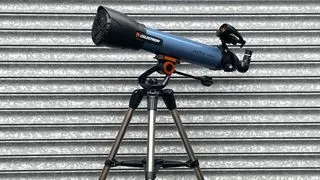 A side profile view of the Celestron Inspire 100AZ star watching telescope against a corrugated iron backdrop
A side profile view of the Celestron Inspire 100AZ star watching telescope against a corrugated iron backdrop
The Celestron Inspire 100AZ includes many helpful accessories, though based on our full review, we suggest upgrading the eyepieces for better star watching experiences. (Image credit: Jamie Carter)
 A close-up of the focusing knob on the Celestron Inspire 100AZ star watching telescope tube
A close-up of the focusing knob on the Celestron Inspire 100AZ star watching telescope tube
This star watching telescope is easy to set up and use, even for those new to astronomy. (Image credit: Jamie Carter)
 A red flashlight accessory that slots into the tripod of the Celestron Inspire 100AZ star watching telescope
A red flashlight accessory that slots into the tripod of the Celestron Inspire 100AZ star watching telescope
A small red flashlight can be slotted in to illuminate the accessory tray, useful for star watching in the dark. (Image credit: Jamie Carter)
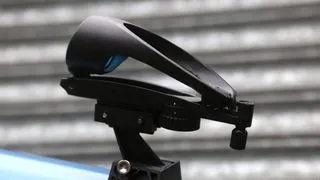 The StarPointer Pro finderscope attached to the Celestron Inspire 100AZ star watching telescope
The StarPointer Pro finderscope attached to the Celestron Inspire 100AZ star watching telescope
A StarPointer Pro finderscope, featuring a bullseye, is positioned close to the eyepiece. (Image credit: Jamie Carter)
 The eyepiece and dust cap accessory for the Celestron Inspire 100AZ star watching telescope
The eyepiece and dust cap accessory for the Celestron Inspire 100AZ star watching telescope
A smartphone can be secured to one side using elastic cords, while an eyepiece fits into the other for astrophotography with this star watching telescope. (Image credit: Jamie Carter)
 Showing the smartphone holder accessory in action on the Celestron Inspire 100AZ star watching telescope
Showing the smartphone holder accessory in action on the Celestron Inspire 100AZ star watching telescope
A smartphone straps to one side using elasticated cords while an eyepiece fits in the other. (Image credit: Jamie Carter)
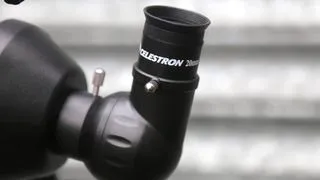 The side profile of the star diagonal on the Celestron Inspire 100AZ star watching telescope
The side profile of the star diagonal on the Celestron Inspire 100AZ star watching telescope
The Celestron Inspire 100AZ comes with 20 mm and 10 mm Kellner eyepieces, useful for various star watching magnifications. (Image credit: Jamie Carter)
Best budget telescope for budding skywatchers who want to get up and running quickly.
Our expert review:
Specifications
Optical design: Refractor
Mount type: Alt-azimuth
Aperture: 3.94-inches / 100mm
Focal length: 660mm
Highest useful magnification: 241x
Lowest useful magnification: 15x
Supplied eyepieces: 10mm, 25mm
Weight: 20 lbs (9.07kg)
Reasons to buy
+Sharp views of planets and the moon
+Handy smartphone adaptor
+Built-in red light
+Lightweight frame
Reasons to avoid
-Bearings lack precision
-Some chromatic aberration
-No solar observing possible
Buy it if:
✅ You’re a beginner looking for a star watching telescope: We found it easy to set up and take down, making it perfect for beginners.
✅ You want to take astro shots on your smartphone: The clever lens cap transforms into a smartphone holder, allowing you to capture images of the night sky.
Don’t buy it if:
❌ You aren’t confident locating objects yourself: This star watching telescope lacks GoTo technology, so you’ll need to be able to locate specific celestial objects manually (or with the aid of a stargazing app).
❌ You want detailed views of deep sky objects: While this telescope provides great views of planets and the moon, more distant objects may appear somewhat less impressive.
The bottom line:
🔎 Celestron Inspire 100AZ: Aimed at beginners and those seeking an upgrade, this 4-inch refractor performs optimally for moon and planet observation. It features a lens cap that converts into a smartphone holder for convenient astrophotography. ★★★★
The Celestron Inspire 100AZ is an excellent choice for beginners seeking a star watching telescope. Its user-friendly features and robust construction make it simple to operate, even for those unfamiliar with astronomy. It’s also a relatively affordable option compared to other telescopes in this guide, making it a great entry point for amateur astronomy telescope enthusiasts.
As an achromatic refractor with a 4-inch/100mm aperture and a moderately short focal length of 660mm, the Celestron Inspire 100AZ is designed for home use to view planets, the moon, and deep sky objects. It sits on a basic altazimuth mount that allows movement side-to-side and up-and-down, complete with a panhandle for locking it into your desired position for star watching.
The 100mm aperture gathers a significant amount of light, enabling clear observations of faint celestial objects like nebulas and galaxies. Furthermore, its relatively long focal length provides substantial magnification for detailed views of planets and closer objects.
During our Celestron Inspire 100AZ review, we observed slight false color (purple fringing) and some blurring towards the edges of the field of view. The latter can be easily resolved by investing in one of the best eyepieces to maximize the Inspire 100AZ’s optical potential. The minor false color issue is generally not a dealbreaker unless you prioritize perfectly accurate colors.
This star watching telescope comes with several accessories, including two eyepieces, a red LED flashlight (to preserve night vision), an accessory tray, and a StarPointer Pro finderscope for locating celestial objects. A feature we particularly appreciated is the lens cap that doubles as a smartphone adapter, allowing you to take astrophotography shots with your phone.
Swipe to scroll horizontally
| Attributes | Notes |
|---|---|
| Design | Fairly lightweight. |
| Performance | Excels with lunar views. |
| Functionality | Easy to set up and take down. |
Celestron Astro Fi 130 – Best Value Star Watching Telescope for Enthusiasts
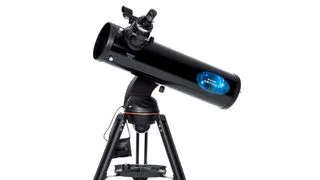 The Celestron Astro Fi 130 star watching telescope on a white background
The Celestron Astro Fi 130 star watching telescope on a white background
The Celestron Astro Fi 130’s wide field of view allows you to observe large galaxies without frequent repositioning, enhancing your star watching experience. (Image credit: B&H Photo)
Best value enthusiast telescope: A guide to the night sky, packed with technology at a low price.
Our expert review:
Specifications
Optical design: Newtonian Reflector
Mount type: Computerized altitude-azimuth single fork
Aperture: 5.19-inches / 130mm
Focal length: 650mm
Highest useful magnification: 307x
Lowest useful magnification: 19x
Supplied eyepieces: 25mm and 10mm
Weight: 18 lbs (8.6kg)
Reasons to buy
+Suitable for modest budgets
+Great entry-level star watching telescope
+Vixen dovetail for mount changes
+Portable
+Computer recommends targets
+Finds targets at touch of button
Reasons to avoid
-Included eyepieces limit observations
-Focuser is of lower quality
-Battery drains quickly
-Useless without app
Buy it if:
✅ You want a beginner-friendly, grab & go, easy-to-use star watching telescope: We found this to be an excellent entry-level telescope that can find targets instantly and is great for on-the-go observations.
Don’t buy it if:
❌ You want a ‘traditional’ telescope: We found this star watching telescope completely non-functional without the app. If you prefer a more traditional telescope without much modern technology, look elsewhere.
The bottom line:
🔎 Celestron Astro Fi 130: A capable telescope offered at an exceptionally good price, providing everything needed for getting started with star watching. However, we recommend upgrading some included components. Note that it can lose charge quickly in cold conditions, so consider an additional power source. ★★★½
Celestron’s Astro Fi 130 is a very competent entry-level star watching telescope with an attractive price point. This well-constructed telescope system includes a Newtonian reflector tube, a sturdy aluminum tripod, 10mm and 25mm Kellner eyepieces (providing 65x and 26x magnification), and a red dot finder. It’s a great option for getting into amateur astronomy telescope viewing.
We highly recommend purchasing some mid-range Plossl eyepieces to get the absolute best performance out of this scope for your star watching sessions. During our Celestron Astro Fi 130 review, we also noted that its batteries can drain quickly in cold weather, so investing in 12V rechargeable batteries might be a wise decision.
This star watching telescope is an excellent choice for beginners. It provides all the necessary tools to embark on a stargazing journey. The SkyAlign technology eliminates the need for prior knowledge of the night sky to set up, and the Celestron SkyPortal app facilitates easy control via your smartphone or tablet. The app can even suggest celestial objects to view and guide the computerized mount directly to them.
The optics on the Astro Fi 130 allow for good views of the moon, providing enough magnification to discern craters and rilles on the lunar surface. Venus and Mars are also easy to observe, and we were even able to catch a glimpse of the Andromeda Galaxy.
Swipe to scroll horizontally
| Attributes | Notes |
|---|---|
| Design | Very sturdy build with well constructed tube and tripod. |
| Performance | Utilizes SkyAlign technology for simple alignment. |
| Functionality | Great for lunar and planetary observing, though some views are fuzzy. |
Celestron NexStar Evolution 9.25 – Best Premium Star Watching Telescope
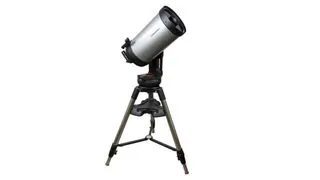 The Celestron NexStar Evolution 9.25 star watching telescope on a tripod on a white background
The Celestron NexStar Evolution 9.25 star watching telescope on a tripod on a white background
Automatically track objects as they move across the sky with this high-quality Catadioptric star watching telescope. (Image credit: B&H Photo)
Best GoTo scope for seeing the universe in HD, albeit with a premium price tag.
Our expert review:
Specifications
Optical design: Schmidt-Cassegrain
Mount type: Computerized alt-azimuth fork arm
Aperture: 9.25-inches / 235mm
Focal length: 2350mm
Highest useful magnification: 555x
Lowest useful magnification: 34x
Supplied eyepieces: 13mm, 40mm
Weight: 62.60 lbs (28.39kg)
Reasons to buy
+Crisp views without defects
+Easy to set up
+High-quality design
Reasons to avoid
-Not very portable — best for backyard star gazing
-Expensive
Buy it if:
✅ You want to view a wide range of subjects with your star watching telescope: This scope features a large aperture, enabling clear and detailed views of a broad spectrum of celestial objects, including planets, deep-sky objects, and nebulas.
✅ You’re an experienced skywatcher: Although its easy setup is convenient for beginners, this star watching telescope is best suited for more advanced, passionate astronomers who desire a comprehensive view of the universe.
Don’t buy it if:
❌ You need something portable: Portability isn’t a strong suit of the Evolution 9.25, making it most suitable for backyard star gazing.
The bottom line:
🔎 Celestron NexStar Evolution 9.25: An outstanding telescope perfectly suited for experienced skywatchers, with a price point reflecting its premium features. While it’s not the easiest to transport, we consider it one of the top GoTo telescopes available. ★★★★½
The Celestron NexStar Evolution 9.25 is an exceptional GoTo star watching telescope that delivers breath-taking views of the night sky. Its Schmidt-Cassegrain optical tube boasts a generous 235mm aperture and is supported by a sturdy single-fork arm mount for stability and precision during your star watching sessions. The motorized mount is powered by a rechargeable lithium-ion battery, offering an impressive 10 hours of continuous stargazing.
This star watching telescope comes with a good selection of accessories, including a red dot finderscope, star diagonal, accessory tray, international AC adapter, hand control, and two eyepieces (13mm and 40mm).
Unlike some less expensive options, the NexStar Evolution 9.25 is a prime choice for more experienced skywatchers seeking a top-tier star watching telescope. While it represents a significant investment, its impressive design and quality features justify the cost for serious enthusiasts.
Astrophotographers may also find this star watching telescope and its motorized mount appealing due to its ability to track celestial object movements. You can easily control the NexStar Evolution 9.25 using the free Celestron SkyPortal app, which eliminates the need for a physical controller and keeps your hands free for photography during shoots.
Despite its impressive design, this star watching telescope is on the heavier side. As such, it is not the most portable option and is best utilized for backyard star watching. Nevertheless, its robust construction and excellent features more than compensate for this limitation if portability isn’t your primary concern.
Swipe to scroll horizontally
| Attributes | Notes |
|---|---|
| Design | A bit bulky and challenging to transport. |
| Performance | Provides crisp views free of defects. |
| Functionality | Motorized mount is a suitable choice for astrophotography. |
Celestron Origin Intelligent Home Observatory – Best Star Watching Telescope for Astrophotography
Image 1 of 5
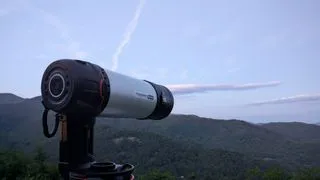 a black and white Celestron Origin star watching telescope in a field
a black and white Celestron Origin star watching telescope in a field
The Celestron Origin resembles a classic Celestron optical tube but notably lacks an eyepiece, focusing on digital star watching. (Image credit: Future/Brett Tingley)
The integrated camera within the Celestron Origin allows you to capture beautiful shots of the night sky, a key feature for this type of star watching telescope. (Image credit: Future/Brett Tingley)
 a black and white Celestron Origin star watching telescope in a field with trees behind it showing the handles
a black and white Celestron Origin star watching telescope in a field with trees behind it showing the handles
There are several handles on the Origin’s mount to facilitate easier carrying of this star watching telescope. (Image credit: Future/Brett Tingley)
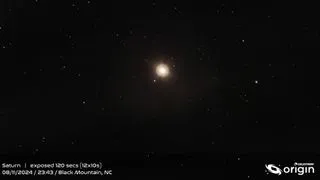 a black and white Celestron Origin star watching telescope in a field with trees behind it viewing Saturn
a black and white Celestron Origin star watching telescope in a field with trees behind it viewing Saturn
The Celestron Origin allowed us to view Saturn, although focusing on planets proved challenging during testing of this star watching telescope. (Image credit: Future/Brett Tingley)
 An example of a sharp astro shot taken without a filter with the Celestron Origin star watching telescope. The subject is the Crescent Nebula (NGC 6888).
An example of a sharp astro shot taken without a filter with the Celestron Origin star watching telescope. The subject is the Crescent Nebula (NGC 6888).
An example of a sharp astrophotography shot taken without a filter using the Celestron Origin. The subject is the Crescent Nebula (NGC 6888). (Image credit: Future/Brett Tingley)
Best for astrophotography: This smart telescope can take clear photos of deep sky objects in seconds.
Our expert review:
Specifications
Optical design: Rowe-Ackermann Schmidt Astrograph (RASA)
Mount type: Motorized Alt-azimuth
Aperture: 6-inches / 152mm
Focal length: 335mm
Highest useful magnification: N/A
Lowest useful magnification: N/A
Supplied eyepieces: N/A
Weight: 41.6 lbs (18.6 kg)
Reasons to buy
+Crystal clear deep sky photos in seconds
+Quick set up
+Easy-to-use, helpful app
+Automatically stacks and processes images
Reasons to avoid
-Not ideal for all celestial objects
-Quite large and heavy
Buy it if:
✅ You want an automated star watching telescope: Focusing, tracking, finding targets, and stacking processed images are all automatic with this model.
✅ You want to take deep sky images: The Origin can accomplish this and more in minutes, requiring minimal prior knowledge, making it a powerful [amateur astronomy telescope] tool.
Don’t buy it if:
❌ You want a traditional telescope: This model lacks an eyepiece, providing views of the night sky only on a mobile device.
❌ You’re on a budget: Priced around $4,000, this star watching telescope is on the expensive side.
The bottom line:
🔎 Celestron Origin Intelligent Home Observatory: This (pricey) smart telescope can autonomously handle every aspect of stargazing and produces stunning photos of the night sky rapidly. ★★★★½
The Celestron Origin Intelligent Home Observatory is a smart star watching telescope unlike traditional models, primarily because it lacks an eyepiece and features a built-in camera instead. Its core function is to allow you to view and image the night sky on a mobile device rather than directly through the telescope.
This design results in beautiful, sharp images of deep sky objects and distant galaxies within seconds, even in areas affected by light pollution. During our Celestron Origin review, we found that within moments of selecting an object in the accompanying app, the telescope could capture crystal clear images of nebulas with almost no noise. We also appreciated the ‘snapshot’ mode, which allows manual adjustment of settings for single photos. However, we had limited success imaging planets, suggesting that more time with the telescope might be needed to fully master planetary observation.
Beginners will appreciate this star watching telescope for its quick and easy setup. It automates every aspect of stargazing, from focusing to tracking targets, making it accessible even without prior astronomy experience. The Origin app is user-friendly and simplifies image capture. The ‘Planetarium View’ displays a representation of the night sky, and tapping an object gives you the option to command the telescope to slew directly to it.
While the Celestron Origin has the appearance of a standard telescope, it doesn’t include an eyepiece as mentioned earlier. It is also quite heavy, making it less suitable as a portable star watching telescope for travel. The price tag, close to $4,000, might deter some prospective buyers, but if your budget permits, we highly recommend this smart telescope for its unique capabilities.
Swipe to scroll horizontally
| Attributes | Notes |
|---|---|
| Design | Bulky, but features useful elements on the mount. |
| Performance | Produces beautiful, clear photos of deep sky objects. |
| Functionality | Features a motorized mount but is not a traditional telescope with an eyepiece. |
Celestron NexStar 8SE – Best Motorized Star Watching Telescope
Image 1 of 7
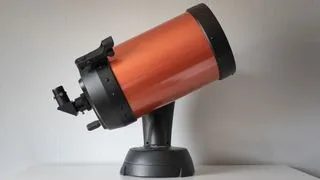 Celestron NexStar 8SE star watching telescope review photo showing uncluttered sides
Celestron NexStar 8SE star watching telescope review photo showing uncluttered sides
The uncluttered sides of the 8SE make it easy to maneuver without damaging components, a practical feature for a star watching telescope. (Image credit: Jason Parnell-Brookes)
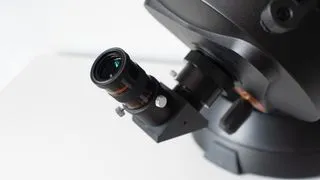 Celestron NexStar 8SE star watching telescope review photo showing the 25mm eyepiece
Celestron NexStar 8SE star watching telescope review photo showing the 25mm eyepiece
The NexStar 8SE includes a 25mm eyepiece. For a closer look at celestial objects, you might consider investing in a 10mm eyepiece for better star watching. (Image credit: Jason Parnell-Brookes)
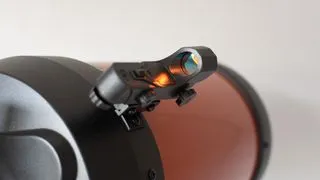 Celestron NexStar 8SE star watching telescope review photo showing the finderscope
Celestron NexStar 8SE star watching telescope review photo showing the finderscope
Although the included NexStar 8SE finderscope appears basic, it is surprisingly effective for locating targets with this star watching telescope. (Image credit: Jason Parnell-Brookes)
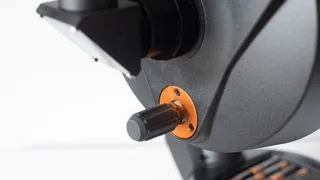 Celestron NexStar 8SE star watching telescope review photo showing the large focus knob
Celestron NexStar 8SE star watching telescope review photo showing the large focus knob
The focus knob is large, easily located in the dark, and operable even while wearing gloves, enhancing usability for star watching. (Image credit: Jason Parnell-Brookes)
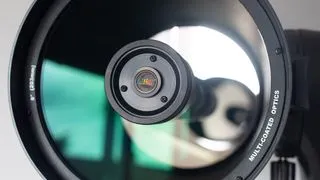 Celestron NexStar 8SE star watching telescope review photo showing the 203.2mm aperture lens
Celestron NexStar 8SE star watching telescope review photo showing the 203.2mm aperture lens
The NexStar 8SE features a 203.2mm aperture lens, allowing for breathtakingly detailed and vivid observations of deep-sky objects, a key capability for this star watching telescope. (Image credit: Jason Parnell-Brookes)
 Celestron NexStar 8SE star watching telescope review photo showing the hand controls
Celestron NexStar 8SE star watching telescope review photo showing the hand controls
The controls on the NexStar 8SE are straightforward, even for beginners, making this star watching telescope accessible. (Image credit: Jason Parnell-Brookes)
 Celestron NexStar 8SE star watching telescope review photo showing the hand controller
Celestron NexStar 8SE star watching telescope review photo showing the hand controller
The Celestron NexStar 8SE is managed via a built-in hand controller, rather than relying on an app. (Image credit: Jason Parnell-Brookes)
Best motorized scope: Ideal for astrophotography and deep space observing, providing excellent image clarity and detail for dedicated star watching.
Our expert review:
Specifications
Optical design: Schmidt-Cassegrain
Mount type: Computerized alt-azimuth fork arm
Aperture: 8-inches / 203mm
Focal length: 2032mm
Highest useful magnification: 480x
Lowest useful magnification: 29x
Supplied eyepieces: 25mm
Weight: 32 lbs (14.48kg)
Reasons to buy
+Incredibly bright views
+Sharpness across the entire field of view
+Pricey, but offers good value for money
Reasons to avoid
-Price might be prohibitive for some beginners
-Slewing using the remote is slightly laggy, but not significantly
Buy it if:
✅ You are looking for a long-term star watching telescope: This telescope, often dubbed ‘The World’s Most Beloved Telescope,’ is an investment that can last for decades.
✅ You want to use it for astrophotography: Thanks to its smooth and accurate tracking, this scope is an excellent option for capturing stunning astro images of deep sky objects.
Don’t buy it if:
❌ You are on a strict budget: Although it offers great value and we recommend it if your budget permits, it is quite expensive. For beginners or those on a tighter budget, numerous more affordable alternatives are available that are perfectly adequate.
The bottom line:
🔎 Celestron NexStar 8SE: An outstanding star watching telescope with incredible optics suitable for beginners, intermediate, and advanced astronomers alike. It’s great for astrophotography and delivers beautifully bright and detailed views. Our only minor reservation is its price point, which might exclude some beginners. ★★★★½
The Celestron NexStar 8SE is one of the most versatile star watching telescopes we’ve reviewed, making it an ideal instrument to learn and grow with. It’s beginner-friendly, requiring no prior knowledge of the night sky, yet its superb optics are capable of satisfying intermediate to advanced astronomers as well. The primary drawback is the price, but if your funds allow, we wholeheartedly recommend it.
The Celestron SkyAlign app assists in aligning the scope using three bright stars, after which the entire operation becomes automated. You simply press buttons on the handheld remote to select your desired celestial object, and the motorized mount automatically slews the telescope towards your target for easier star watching. You can select from various object categories, including ‘solar system,’ ‘stars,’ or ‘deep sky,’ or choose ‘sky tour,’ which automatically selects objects of interest based on your location.
Featuring an 8-inch aperture and a Schmidt-Cassegrain optical design, this star watching telescope is capable of gathering a vast amount of light, providing bright and clear views of objects within our solar system and beyond. The catadioptric construction, combining both refraction and reflection, has enabled Celestron to maintain the distinctive orange tube’s relatively short length, making it eminently portable for travel to darker skies.
In our Celestron NexStar 8SE review, we were significantly impressed by the smoothness and accuracy of the motorized fork arm, deeming it an excellent option for those interested in long-exposure astrophotography. However, this star watching telescope requires a substantial 8x AA batteries. To mitigate future costs, we strongly advise purchasing rechargeable batteries for this power-hungry scope. This is particularly important given the capabilities of the Celestron NexStar 8SE, which suggest you’ll likely be using it for many years to come.
Swipe to scroll horizontally
| Attributes | Notes |
|---|---|
| Design | Can be transported as a fully-assembled setup. |
| Performance | Outstanding optics; alignment can be slightly tricky if unfamiliar. |
| Functionality | Easy to assemble and disassemble. |
Celestron Astro Fi 102 – Best Portable Star Watching Telescope
Image 1 of 7
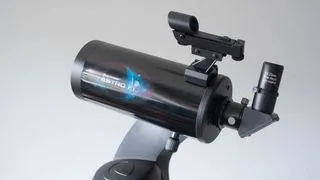 The Celestron Astro Fi 102 star watching telescope
The Celestron Astro Fi 102 star watching telescope
The telescope’s appearance may not be the most aesthetically pleasing, possibly even perceived as ‘toyish,’ but the optical quality is good for a star watching telescope. (Image credit: Jason Parnell-Brookes)
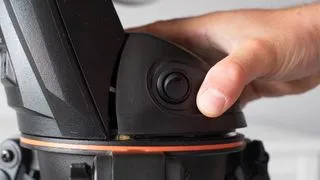 The Celestron Astro Fi 102 star watching telescope showing the finish
The Celestron Astro Fi 102 star watching telescope showing the finish
While this star watching telescope is very portable, we found its finish doesn’t feel particularly premium. (Image credit: Jason Parnell-Brookes)
 The Celestron Astro Fi 102 star watching telescope showing eyepieces
The Celestron Astro Fi 102 star watching telescope showing eyepieces
The telescope includes a 25 mm eyepiece and a 10mm eyepiece, providing 53x and 132.5x magnification respectively for versatile star watching. (Image credit: Jason Parnell-Brookes)
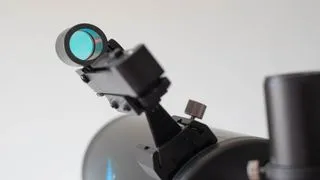 The Celestron Astro Fi 102 star watching telescope showing the finderscope attachment
The Celestron Astro Fi 102 star watching telescope showing the finderscope attachment
The finderscope is easily attached to the tube, simplifying setup for this star watching telescope. (Image credit: Jason Parnell-Brookes)
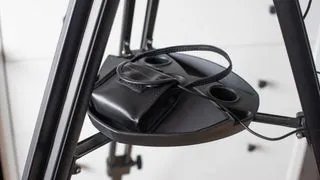 The Celestron Astro Fi 102 star watching telescope accessory tray
The Celestron Astro Fi 102 star watching telescope accessory tray
The accessory tray is helpful for keeping your gear organized and accessible in the dark during star watching sessions. (Image credit: Jason Parnell-Brookes)
 The Celestron Astro Fi 102 star watching telescope battery pack
The Celestron Astro Fi 102 star watching telescope battery pack
The battery pack requires 8 AA batteries. We felt the cable connection could be more robust for this star watching telescope. (Image credit: Jason Parnell-Brookes)
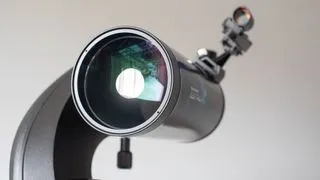 The Celestron Astro Fi 102 star watching telescope optical tube assembly dimensions
The Celestron Astro Fi 102 star watching telescope optical tube assembly dimensions
The optical tube assembly measures 38.1cm in length and 11.7cm in diameter, contributing to its portability as a star watching telescope. (Image credit: Jason Parnell-Brookes)
Best lightweight and portable go-to mount scope for beginner sky watchers.
Our expert review:
Specifications
Optical design: Maksutov-Cassegrain
Mount type: Computerized Alt-Azimuth Single Fork Arm
Aperture: 4.0-inches / 102mm
Focal length: 1325mm
Highest useful magnification: Up to 100x with digital zoom
Lowest useful magnification: 15x
Supplied eyepieces: 25mm and 10mm
Weight: 6 lbs (2.7kg)
Reasons to buy
+Highly portable due to its lightweight design
+Reasonably and fairly priced
+No prior experience needed
Reasons to avoid
-Optics could be better
-Tripod isn’t the best quality
-Does not feel like a premium product to the touch
Buy it if:
✅ You will be traveling with your star watching telescope: This scope is our top choice for portability, making it perfect for camping trips or excursions to darker skies.
✅ You are a beginner: If you primarily want to observe the moon and some planets, this is an excellent star watching telescope choice.
Don’t buy it if:
❌ You expect high-quality components: This telescope embodies ‘you get what you pay for’ to some extent. While adequate for basic astronomy, the tripod quality is not top-tier, the optics could be better, and it lacks a premium feel.
The bottom line:
🔎 Celestron Astro Fi 102: Best suited for viewing the moon and planets, this star watching telescope is great for beginners and those with no prior experience. Initial setup can be slightly tricky, and it’s not the highest quality scope we’ve reviewed, but it effectively performs its function. ★★★½
The Celestron Astro Fi 102 offers several advantages for newcomers to astronomy. It’s relatively simple to set up, features a motorized mount that automatically slews to your selected target, and is affordably priced for a Maksutov-Cassegrain scope. It also includes a range of convenient features and accessories to help you get started with star watching.
One of the aspects we particularly liked about this scope in our Celestron Astro Fi 102 telescope review was its portability. Its compact body and low weight of just 6 lbs (2.7kg) make it extremely easy to carry into the field. A word of caution, though: it’s not as robust as some pricier scopes and likely wouldn’t withstand getting wet, so bring a cover for unexpected rain. We also felt it would be more stable with a sturdier tripod, as the included one felt somewhat flimsy and required additional weighting.
This star watching telescope comes with integrated WiFi, allowing pairing with your phone via the Celestron SkyPortal app. The app contains a database of approximately 100,000 celestial objects that you can select for the telescope to automatically point to, making it easy for beginners to navigate the sky without prior knowledge.
For its price point, the Celestron Astro Fi 102 provides good views of the moon and its craters, as well as closer planets like Mars, Saturn, and Jupiter. Under favorable conditions, you might also catch a glimpse of Uranus or Neptune. There is some noticeable sharpness drop-off towards the edges, but avoiding this generally requires purchasing a significantly more expensive scope.
The plastic casing is acceptable, but we doubt it would survive a substantial impact or getting soaked in a passing shower, as the seals are not as robust as those on some more durable, fully-sealed telescopes available for star watching. This is a good option for an amatuer telescope focused on portability.
Swipe to scroll horizontally
| Attributes | Notes |
|---|---|
| Design | Highly transportable, but tripod needs weighing down. |
| Performance | Initial setup can be tricky, but becomes easy after that. |
| Functionality | Large database of celestial objects available on SkyPortal app. |
Sky-Watcher Skymax 150 PRO – Best Star Watching Telescope for Accessories
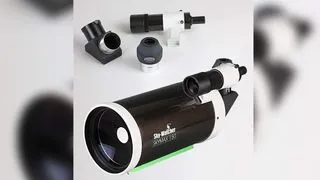 The Sky-Watcher Skymax 150 PRO star watching telescope and accessories laid out on a white table
The Sky-Watcher Skymax 150 PRO star watching telescope and accessories laid out on a white table
This scope is a versatile star watching telescope for astrophotography, capable of capturing everything from planets to deep-sky subjects. (Image credit: Amazon)
Best for accessories: The Skymax 150 PRO can accommodate CCD or DSLR cameras, filter wheels, and other add-ons.
Our expert review:
Specifications
Optical design: Maksutov-Cassegrain
Mount type: Equatorial (EQ-5 Pro)
Aperture: 5.90-inches / 150mm
Focal length: 1800mm
Highest useful magnification: 450x
Lowest useful magnification: 36x
Supplied eyepieces: 28 mm
Weight: 13.23 lbs (6kg)
Reasons to buy
+High-quality, lightweight construction
+Excellent optics
+Great for a wide selection of astrophotography
Reasons to avoid
-Not all models include a tripod
-Comes with only one eyepiece
Buy it if:
✅ You intend to travel with your star watching telescope: Much of astrophotography involves visiting dark sky sites, and this telescope is light enough for easy transport.
✅ Your primary focus is astrophotography: We recommend this telescope as one of the best for astrophotography due to its amazing optics.
Don’t buy it if:
❌ You are looking for something extremely sophisticated: For those seeking high-end, complex instruments with a matching budget, a smart telescope would likely be a better fit.
The bottom line:
🔎 Sky-Watcher Skymax 150 PRO: This star watching telescope is perfectly suited for astrophotographers who need portability for shoots. It features excellent quality optics and a great build. It can accommodate numerous accessories, although note that a tripod is not included with all models. ★★★★
The Sky-Watcher Skymax 150 is an excellent choice for astrophotographers, particularly because of its high-quality equatorial mount which supports both short and long-exposure shots. Its design makes it a solid [amateur astronomy telescope] option for imaging.
Weighing in at just 13.23 lbs (6kg), this star watching telescope is light enough to easily transport to different locations in pursuit of darker skies. It pairs well with many equatorial mounts and readily accepts additional accessories like CCD or DSLR cameras, filter wheels, and other add-ons. It also includes a Vixen-style dovetail plate for straightforward mount attachment.
This well-built Maksutov-Cassegrain telescope comes with a 28mm focal length eyepiece, providing 64x magnification, which allows for detailed views of various celestial objects during your star watching.
The optics of the Skymax 150 are impressive, delivering crisp, distortion-free views. It’s a versatile star watching telescope, perfectly suited for capturing images of planets or distant galaxies and nebulas. It is also user-friendly and easy to accessorize, making it a great choice for astronomers and astrophotographers of all skill levels. We also believe the Skymax 150 offers very good value compared to some other products on this list.
The focuser operates very smoothly, and the telescope maintains a good amount of fine focus once achieved, which is crucial for long astrophotography sessions.
If this isn’t the ideal star watching telescope for your needs but you’re still interested in a Sky-Watcher scope, check out our Sky-Watcher deals hub to discover more models from the brand.
Swipe to scroll horizontally
| Attributes | Notes |
|---|---|
| Design | High-quality build, excellent optics. |
| Performance | Outstanding optics, with no visible distortion. |
| Functionality | Great for a wide range of astrophotography applications. |
Unistellar eQuinox 2 telescope – Best Smart Star Watching Telescope
Image 1 of 3
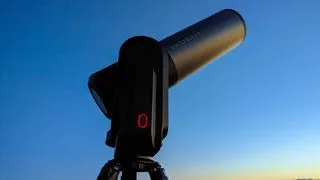 Unistellar eQuinox 2 smart star watching telescope in use against night sky
Unistellar eQuinox 2 smart star watching telescope in use against night sky
The Unistellar eQuinox 2 can smoothly and silently slew to night sky objects and image them within minutes of unpacking, making it a convenient smart star watching telescope. (Image credit: Jason Parnell-Brookes)
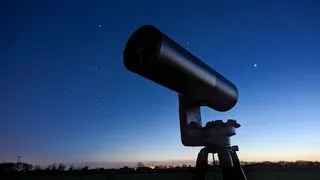 Unistellar eQuinox 2 smart star watching telescope in use against starry sky
Unistellar eQuinox 2 smart star watching telescope in use against starry sky
Only a single button is visible on the eQuinox 2 telescope – the power button, which glows red when on and connected. (Image credit: Jason Parnell-Brookes)
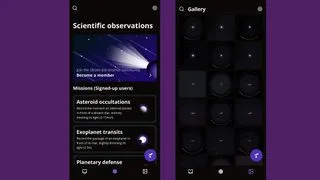 Screenshots of the Unistellar app in use with the eQuinox 2 smart star watching telescope
Screenshots of the Unistellar app in use with the eQuinox 2 smart star watching telescope
All functions of this star watching telescope are accessible via the accompanying app. (Image credit: Jason Parnell-Brookes)
Best smart telescope: This smart telescope offers simple astronomy powered by a clever smartphone app.
Our expert review:
Specifications
Optical design: Newtonian Reflector
Mount type: Motorized GoTo alt-azimuth
Aperture: 4.49-inches / 114mm
Focal length: 450mm
Highest useful magnification: 400x digital
Lowest useful magnification: 50x optical
Supplied eyepieces: N/A
Weight: 19.8 lbs (9kg)
Reasons to buy
+Beautiful, simple layout and design
+Achieve views of the night sky quickly
+App is easy to operate
Reasons to avoid
-Image resolution is average
-Cannot orientate telescope in twilight
-Laggy views when focusing
Buy it if:
✅ You live in an urban area: This scope features a Smart Light Pollution Reduction function that effectively mitigates light pollution, making it an excellent option if you aren’t near a dark sky site for star watching.
✅ You desire simplicity: This is an incredibly sleek, all-in-one star watching telescope that requires no additional accessories and can guide you effortlessly to your chosen celestial objects.
Don’t buy it if:
❌ You are on a budget: As expected, this is an expensive piece of equipment, likely pricing out most beginners and those without a substantial budget.
The bottom line:
🔎 Unistellar eQuinox 2: An easy-to-use motorized smart star watching telescope capable of locating night sky objects with a tap of a button. The eQuinox 2 allows you to begin exploring the stars within minutes, even without prior knowledge, though its built-in camera’s detail level is only average. ★★★★½
The Unistellar eQuinox 2 integrates the latest smart technology into a sleek, modern motorized reflector telescope. It features a single power button on the fork arm, with all other controls managed through the Unistellar app. Unlike conventional telescopes, the Unistellar eQuinox 2 does not include a finderscope, eyepieces, or other accessories, as it doesn’t require them for operation as a smart star watching telescope.
The telescope incorporates a 6.2MP image sensor (an upgrade from the previous 4.9MP sensor), which captures multiple images sequentially and stacks them to create the appearance of a long exposure. As a result, objects become brighter as the image displayed on your phone or tablet screen updates in real-time.
While this approach might not appeal to astronomers who prefer a more traditional method of sky-watching, it offers specific benefits for stargazing in urban locations thanks to the Smart Light Pollution Reduction feature, which minimizes the impact of light pollution during viewing. We also appreciate the ease of saving and sharing photos of what you observe in real-time.
During our Unistellar eQuinox 2 review, we found the setup quick and easy using the Autonomous Field Detection feature. Following setup, you can use Unistellar’s intuitive app to automatically navigate to different objects in the night sky. The menu screen presents a selection of objects currently available for viewing, as well as those expected to appear within the next few hours. Alternatively, you can search for a specific object of interest within their extensive database of 37 million stars and over 5,000 celestial objects for your star watching.
It’s important to note, however, that this high-tech star watching telescope carries a price tag of around $2,000. If your budget allows for this expense, the Unistellar eQuinox 2 could be the ideal telescope for you.
Swipe to scroll horizontally
| Attributes | Notes |
|---|---|
| Design | Slim, sleek, neat package. |
| Performance | Quick GoTo location of night sky objects. |
| Functionality | Doesn’t orientate until well after twilight; easy once oriented. |
Celestron Advanced VX 8 EdgeHD – Best Star Watching Telescope for Deep Space
Image 1 of 4
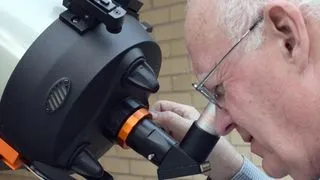 Review photo of the Celestron Advanced VX8 Edge HD star watching telescope with its mount
Review photo of the Celestron Advanced VX8 Edge HD star watching telescope with its mount
The Celestron Advanced VX8 is packaged with Celestron’s imager-focused Advanced VX mount, a robust base for a star watching telescope. (Image credit: Future/Michael Covington)
 Review photo of the Celestron Advanced VX8 Edge HD star watching telescope mount and controls
Review photo of the Celestron Advanced VX8 Edge HD star watching telescope mount and controls
The computerized mount finds celestial objects, accepting commands from the hand box or via USB from your PC, enhancing precision for a star watching telescope. (Image credit: Future/Michael Covington)
 Review photo of the Celestron Advanced VX8 Edge HD star watching telescope with camera attachment
Review photo of the Celestron Advanced VX8 Edge HD star watching telescope with camera attachment
An astrocamera (not included) or DSLR attaches where the eyepiece would be for photography through this star watching telescope. (Image credit: Future/Michael Covington)
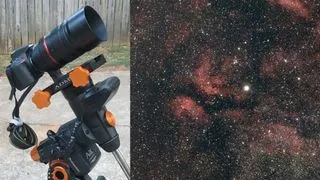 Review photo of the Celestron Advanced VX mount carrying camera and telephoto lens for deep-sky images
Review photo of the Celestron Advanced VX mount carrying camera and telephoto lens for deep-sky images
The Advanced VX mount (an older version is shown with an aftermarket saddle) can support a camera and telephoto lens for capturing dramatic deep-sky images with a star watching setup. (Image credit: Future/Michael Covington)
Best for pinpoint sharpness across the whole field of view, this is a star watching telescope tailored for veteran astronomers.
Our expert review:
Specifications
Optical design: Schmidt-Cassegrain
Mount type: Motorized equatorial
Aperture: 8-inches / 203.2mm
Focal length: 2032mm
Highest useful magnification: 480x
Lowest useful magnification: 29x
Supplied eyepieces: 40mm
Weight: 61 lbs (27.67kg)
Reasons to buy
+EdgeHD technology provides the best optics available in this size class
+Computerized mount reliably finds and tracks objects
+Dovetail mount system
+Proven design refined over years in the market
Reasons to avoid
-Setup requires some prior knowledge of the sky
-Only one eyepiece is supplied
-Requires a sturdier mount for serious long-exposure photography
Buy it if:
✅ You want to observe everything: While some telescopes are optimized for either the moon/planets or deep space, this star watching telescope is excellent for viewing all types of celestial objects.
✅ You desire a seamless experience: We found the motorized mount on this telescope to be very smooth and precise.
Don’t buy it if:
❌ You are a beginner: This star watching telescope is designed for those with experience and knowledge of the sky and telescopes. If you’re just starting out, we suggest a more beginner-friendly model.
❌ You need something lightweight: At 61 lbs (27.67kg), this telescope is heavier than most other options in this guide.
The bottom line:
🔎 Celestron Advanced VX 8 EdgeHD: Intended for serious amateur astronomers, this optically superb telescope is suitable for all forms of visual astronomy with its robust, relatively lightweight computerized mount. If you know your way around the sky and plan to pursue astronomy long-term, this is the star watching telescope to acquire. ★★★★½
Celestron’s EdgeHD technology significantly enhances Schmidt-Cassegrain telescopes, particularly benefiting astrophotography. Typically, these telescopes have a curved focal plane that doesn’t align with the flat surface of a CCD camera sensor, leading to field curvature where stars at the edges of the image appear blurry. However, Celestron’s EdgeHD technology solves this issue by providing a perfectly flat field. This allows astrophotographers to capture sharp and detailed photos across the entire frame without any blur, making it an outstanding [amateur astronomy telescope] for imaging.
During our Celestron Advanced VX 8 EdgeHD review, we were pleased to confirm that the optics in the EdgeHD effectively eliminate blurred edges, creating a perfectly flat field right to the edge for pinpoint sharpness throughout the entire image. The optical performance of the Celestron Advanced VX 8 EdgeHD is impressive, offering crisp and clear views without optical distortion or false color during star watching.
The Celestron Advanced VX 8 EdgeHD can support a weight of up to 30 lbs (13.6kg), ensuring stable and secure support for the tube and all your accessories. The package includes the standard NexStar+ hand controller, a 40mm eyepiece, and access to Celestron’s SkyPortal app and Starry Night Special Edition software.
As an added benefit, the optical tube assembly comes with Celestron’s Advanced VX mount, specifically designed for photographers. This mount can capture images across the meridian (an imaginary north-south line) without requiring a meridian flip. The system also includes periodic error correction for tracking objects and an auto guider port.
Views of Saturn and Jupiter through this star watching telescope are dramatic. Globular clusters are resolved into individual stars. All Messier Objects are plainly visible. With a skilled eye and a dark rural sky, galaxies are visible down to 12th magnitude. It’s truly a star watching telescope you won’t outgrow.
Check out our Celestron deals page to see if you can find a bargain on this or other Celestron models.
Swipe to scroll horizontally
| Attributes | Notes |
|---|---|
| Design | EdgeHD optical design surpasses standard Schmidt-Cassegrain. |
| Performance | Reliably finds and tracks celestial objects. |
| Functionality | Provides excellent views of all types of celestial objects. |
Celestron FirstScope 76 Tabletop telescope – Best Star Watching Telescope for Kids
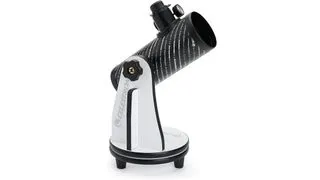 Celestron FirstScope 76mm Tabletop star watching telescope on a white background
Celestron FirstScope 76mm Tabletop star watching telescope on a white background
The Celestron FirstScope is a low-budget tabletop instrument designed to ignite star watching enthusiasm in children. (Image credit: Amazon)
Best tabletop telescope suitable for on-the-go astronomers with small hands.
Our expert review:
Specifications
Optical design: Reflector
Mount type: Dobsonian
Aperture: 2.99-inch / 76mm
Focal length: 11.81-inch / 300mm
Highest useful magnification: 180x
Lowest useful magnification: 11x
Supplied eyepieces: 4mm, 20mm
Weight: 4.5 lbs / 2.04kg
Reasons to buy
+Portable
+Easy to use
+Robust build
+Low investment for casual or young astronomers
+Fast focal ratio for easy observations of wide-angle targets
Reasons to avoid
-Loose focuser
-Some observations lack clarity and detail
-Challenging to collimate
-Finderscope not supplied
Buy it if:
✅ You want a low-investment star watching telescope: This telescope is a great, affordable option for casual viewing.
✅ You don’t want a complicated setup: It arrives pre-assembled and ready to use, eliminating any complex setup process.
Don’t buy it if:
❌ You want to find objects easily: A finderscope is not included, which might be frustrating for anyone wanting to locate specific celestial objects easily.
❌ You want all included extras: This package doesn’t include a finderscope, so you’ll need to purchase one separately or consider a different telescope package that does.
The bottom line:
🔎 Celestron FirstScope 76 Tabletop Telescope: If you have children who are eager for a telescope and you’re not ready to commit to a moderately-priced instrument, the FirstScope could be the perfect solution, especially if the moon and casual glances at the night sky are of interest. ★★★★
As its name suggests, the Celestron FirstScope 76 is designed as a child’s initial star watching telescope. True to this purpose, it’s exceptionally easy to set up and use, arriving fully assembled in the box. It’s ready for action as soon as you open it, which is perfect for impatient kids keen to start their star watching adventure. It serves well as an initial [hobby telescope].
In our Celestron FirstScope 76 Tabletop telescope review, we noted its suitability for small hands, as the tube can be easily maneuvered to point at the desired target. It’s also adequately equipped for decent night sky observations with two basic eyepieces included – 4mm and 20mm. It features a 76mm aperture (nearly three inches) and a fast focal ratio of f/3.95, allowing you to spot celestial objects and even some fainter deep-sky targets. While you won’t get close-up views, it’s sufficient for newcomers to the field. Although not perfectly pin-sharp, we were impressed by the great views of craters we observed, considering them an excellent starting point.
You’ll notice the telescope’s short base, which means you’ll need to place it on a table for comfortable use. While this might be a minor inconvenience for some observers, if you have children persistently asking for a telescope, the FirstScope is a fantastic solution, especially given its compact size and ease of use as a star watching telescope.
The Celestron FirstScope 76 is highly portable, weighing only 4.5 lbs (2.04kg). However, being a tabletop telescope, it’s not really designed for use in the wilderness as it requires a stable surface. If you’re concerned about its low price point, don’t be; the Celestron FirstScope is built very sturdily using durable, non-glossy plastics, giving it a look and feel that seems more premium than its cost.
Perhaps our only significant complaint about the FirstScope is the absence of a finderscope—a tool vital for aligning the telescope. Including one would significantly enhance the overall experience for young astronomers, so we strongly recommend purchasing a red dot finder to accompany this star watching telescope (they are thankfully relatively inexpensive).
Swipe to scroll horizontally
| Attributes | Notes |
|---|---|
| Design | Good quality build for the price. |
| Performance | Provides a ‘wow factor’ for young observers. |
| Functionality | Optics struggle to pick out fine detail. |
Star Watching Telescope FAQ
How do I choose the right star watching telescope for me?
Selecting the ideal star watching telescope can be a significant challenge, especially for beginners. The field is often filled with technical jargon and terminology. Furthermore, you have hundreds of options available, varying widely in configurations, settings, and price points.
The positive news is that the quality of telescopes has dramatically improved in recent years, so most models today offer generally good quality; it’s unlikely you’ll end up with a complete disappointment. Nevertheless, some options are superior to others, and our aim in this guide is to feature only the very best star watching telescope options.
The most crucial factor when choosing a star watching telescope is the optical quality it provides. You also need to consider the aperture size, and whether you require a more portable model or a larger, more powerful one. Beginner telescopes are an excellent starting point if you’re new to the hobby.
To achieve the best possible views during your star watching sessions, you’ll also need to consider your observing location, the specific objects you wish to view, your setup if you plan on attempting astrophotography, and more. If you plan to travel with your star watching telescope, weight and portability are additional factors to take into account.
We strongly advise purchasing your star watching telescope from reputable dealers. This ensures you receive exactly what you ordered, and many will provide a warranty with your purchase. Businesses specializing in astronomical equipment also tend to offer competitive deals and have advisors available to help you make the right decision for your star watching needs.
Below, you will find a breakdown of the different types of telescopes available and our recommendations for the best models in each category.
What types of star watching telescope are there?
There are three primary types of telescopes commonly used for star watching: reflector, refractor, and catadioptric telescopes.
Reflector telescopes utilize a main mirror to collect and focus light, while refractor telescopes employ an objective lens. Catadioptric telescopes combine both a main mirror and a lens of the same diameter. All three types have ‘sub-types’ with variations in their design. For instance, the most basic reflector telescopes follow a Newtonian design, featuring a main mirror and a smaller, secondary mirror positioned to divert light at a right angle to the eyepiece at the top of the telescope tube, making it easier for the observer using a star watching telescope.
As mentioned earlier, today’s market offers an extensive range of quality (and relatively affordable!) telescopes, providing ample choices for a star watching telescope. So, which type should you choose? We believe that Newtonian reflector telescopes mounted on a simple undriven alt-azimuth base (known as a ‘Dobsonian’) offer the best value in terms of aperture size for star watching.
However, if you are interested in learning to navigate the night sky “the traditional way,” a Dobsonian telescope might be the ideal choice for your star watching telescope. They are typically simple instruments without advanced features, meaning you’ll need to use a star map to orient yourself during stargazing. Dobsonians excel at collecting light and offer sufficient resolving power to deliver breath-taking views of celestial objects. Dobsonian telescopes with apertures larger than 6 inches tend to be quite substantial and might require careful consideration for storage space, perhaps in a garden shed or garage. They are excellent as a [hobby telescope].
Adding an equatorial or computerized mount significantly increases the cost of Newtonian or refractor telescopes. You can find various types of computerized mounts for Newtonian telescopes: Dobsonians (push-to or GoTo), single time-mounted (tracking or GoTo), and German equatorial (GoTo). As a reference, a computerized push-to Dobsonian star watching telescope might cost approximately twice as much as a manual model of the same aperture, while a GoTo version could be nearly four times the price of its manual counterpart. A premium Newtonian on a German equatorial mount can even be up to ten times more expensive than one on a manual mount!
If ease of use, portability, and convenience are high priorities, and you enjoy gadgets, a short focal length refractor up to 4 inches or a catadioptric (Schmidt- or Maksutov-Cassegrain) up to 5 inches on a computerized mount could perfectly meet your needs for a star watching telescope. These are versatile telescopes offering high magnification, allowing you to observe incredible details on the moon and planets.
Achromatic refractors with short focal lengths typically exhibit some degree of false color (color fringing) around the edges of bright objects like the moon because they cannot precisely focus all wavelengths of light to a single point. Most users accept this drawback because refractors are generally easy to use and maintain. However, if you desire a clean, high-contrast view without false color from your star watching telescope, the Maksutov design is often the preferred option in this category.
The best views of the night sky are often achieved with apochromatic refractors. Utilizing special glass objectives, they focus nearly all wavelengths of light to a single point and are largely free of false color. It’s worth noting, however, that apochromats cost approximately four times as much as achromatic refractors of equivalent size. The decision of whether to invest this amount of money in your star watching hobby is a personal one.
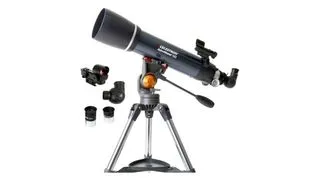 The Celestron AstroMaster 102AZ refractor star watching telescope and accessories on a white background
The Celestron AstroMaster 102AZ refractor star watching telescope and accessories on a white background
Refractors are typically supplied with a simple alt-azimuth mount, allowing movement from left to right and up and down, facilitating basic star watching. (Image credit: Amazon)
How does a refractor star watching telescope work?
Refractors function by bending—or refracting—the light they gather to provide you with a view of your astronomical target. Easy to set up, the refractor is best suited for planetary and lunar viewing, using lenses to collect and focus light to form an image, while an eyepiece magnifies the view. Its simple operation makes it a popular choice for an [amatuer telescope].
The refractor star watching telescope features a relatively straightforward design, with a main objective lens at one end and a star diagonal with a threaded eyepiece at the other. Being intuitive to use, the refractor is often a favored instrument for novice astronomers due to its low maintenance requirements. Refractors are usually attached to a simple alt-azimuth mount, which allows movement side-to-side and up-and-down to locate a desired target. This ease of use also contributes to their simpler manufacturing process (at least for beginner models) and, consequently, lower purchase cost.
The downside is that as the aperture increases, the price of the refractor star watching telescope also increases significantly. Unfortunately, this also makes basic refractors a prime target for replication by mail-order catalogs and non-reputable vendors, so caution is needed when purchasing this type.
Refractors are particularly adept at providing highly magnified and high-contrast images. Because of this, they are ideal instruments for observing solar system targets such as the moon and the planets during star watching sessions. The best refractors typically have an aperture of 2 inches (60mm) or larger and will provide reasonable views of astronomical objects. A 3 to 4-inch (80mm – 90mm) aperture would be better suited if you are looking for a larger aperture.
A drawback of refractors is that they can suffer from chromatic aberration, also known as color fringing. This occurs when a single lens fails to focus all colors emitted from a target object to the same point, often resulting in a colored halo around bright objects like the moon, Venus, or Jupiter during star watching. To mitigate this problem, many refractors are manufactured as achromatic or APOchromatic (also known as Extra Dispersion (ED) telescopes).
The achromatic refractor is less expensive than the apochromatic refractor and, combined with its efficiency, is often the type of star watching telescope chosen by novice astronomers. Even with the more expensive achromatic types, you are likely to observe a stubborn degree of purple fringing around some targets. Unless you are a seasoned skywatcher able to afford the more expensive apochromatic option – which corrects for this effect by using exotic glass for the lenses – this degree of color fringing is unlikely to significantly diminish your observing experience. If you choose the expensive option, the views through these excellent telescopes will likely be stunning. Be aware, however, that some apochromats may not include a tripod, which you would need to purchase separately along with any other desired accessories for your star watching telescope.
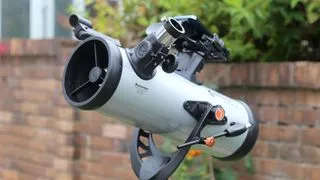 Celestron StarSense Explorer LT 114AZ reflector star watching telescope pointing at the sky against a brick wall backdrop
Celestron StarSense Explorer LT 114AZ reflector star watching telescope pointing at the sky against a brick wall backdrop
Reflector telescopes are excellent for observing low-magnification targets such as galaxies and nebulas, making them versatile star watching telescopes. (Image credit: Jamie Carter)
How does a reflector star watching telescope work?
There are two common types of reflector telescope used for star watching: the Newtonian and the Dobsonian. The fundamental mechanism by which these instruments operate is the same—they both use mirrors to reflect light and create an image of the object you are observing. This mirror-based system is key to their function as a star watching telescope.
The Newtonian telescope design includes a curved main mirror for collecting light, located at the base of the tube. The light that strikes this mirror is reflected back towards the front of the tube, where a smaller flat mirror, angled at 45 degrees, redirects the light towards the observer’s eye, making it visible through the eyepiece. This design is common in many [amatuer telescope] setups.
Newtonian telescopes can be found on alt-azimuth mounts, but it’s more common to see this type of reflector attached to an equatorial mount. Equatorial mounts allow the telescope to follow the apparent rotation of the sky while aligned with your hemisphere’s celestial pole. This type of reflector is a favorite within the amateur astronomy community due to its versatility for observing a wide range of astronomical targets and its suitability for astrophotography. With Newtonians, you can also acquire a large aperture for less money compared to refractors; for example, an eight-inch (203.2mm) reflector would be less expensive than a refractor of the same aperture, offering greater value for your star watching telescope purchase.
Newtonian reflector telescopes do require some maintenance. The mirrors need periodic alignment to ensure they are properly reflecting light. Over time, the mirrors can also become tarnished, potentially requiring repainting. If you choose a Newtonian reflector star watching telescope, selecting one with a protective mirror coating is advisable. This coating helps extend the life of the mirrors and simplifies their maintenance.
Some beginners to the hobby of astronomy might find setting up and using an equatorial mount challenging—this is where the Dobsonian design comes in. These telescopes offer the capabilities of a reflector without the complexities of an equatorial mount, as they use a simpler alt-azimuth mount. Dobsonians are very straightforward to use and can be easily moved to orient towards astronomical objects. If you are not confident in manually navigating your telescope, motorized GoTo or computerized Dobsonians and Newtonians are available. These models automatically slew to objects using a built-in motor but come at a higher cost. Learn more about these in our ‘What are Dobsonian telescopes’ guide. Dobsonians are often considered great for a [hobby telescope].
Regardless of the type of reflector you choose, these telescopes are excellent for viewing low-magnification targets like galaxies and many nebulas, making them effective star watching telescopes for these objects.
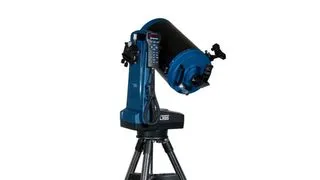 Product photo of Meade Instruments LX65 GoTo catadioptric star watching telescope
Product photo of Meade Instruments LX65 GoTo catadioptric star watching telescope
The short optical tube allows high power magnifications in smaller packages, a hallmark of many catadioptric star watching telescopes. (Image credit: B&H Photo)
How does a catadioptric star watching telescope work?
Ideal for astrophotography, the catadioptric telescope is an excellent instrument for capturing a wide variety of astronomical targets. It is designed to combine the best aspects of two types of telescopes: the reflector and the refractor. Furthermore, the catadioptric design takes advantage of a lightweight build, making it significantly more portable than other telescope types, and its sealed optics typically require minimal maintenance. The main drawback of choosing a catadioptric star watching telescope is that they are generally expensive. However, if you are on a strict budget, acquiring one of these instruments is not impossible – you just need to shop around diligently.
While refractors use lenses and reflectors use mirrors to create and magnify an image, the catadioptric star watching telescope employs both lenses and mirrors to achieve high-definition and superior views. During observations, light from your chosen target passes through a lens, which corrects or reduces aberrations that can distort the view seen through the eyepiece. Curved primary mirrors then reflect this light onto a secondary mirror, which subsequently directs it to your eye. You will encounter two main types of catadioptric telescopes: the Schmidt-Cassegrain and the Maksutov-Cassegrain.
The Maksutov-Cassegrain, often affectionately called the ‘Mak,’ addresses an optical issue experienced by reflectors – an aberration known as ‘coma,’ which can make objects appear distorted with a tail-like effect. This effect is reduced or eliminated through the combined effort of a spherical mirror and a meniscus lens, the latter of which is ‘weakly negative.’ The Maksutov is also effective at correcting for chromatic aberration, or color fringing, a distortion that creates an unwanted purple or blue edge around bright night-sky objects. This makes it a preferred [amateur astronomy telescope] for visual observers.
Packed into its short optical tube is a system that enables you to view higher magnification objects such as planets, the moon, and double stars with this star watching telescope. Additionally, if you struggle to locate objects and navigate the night sky manually, both this type of catadioptric telescope and the Schmidt-Cassegrain are widely available equipped with a GoTo system, albeit at a higher cost.
The other common type of catadioptric, the Schmidt-Cassegrain, offers capabilities similar to the Maksutov and is suitable for general observations of planetary targets and stars. It’s also possible to expand the telescope’s field of view with corrector lenses, allowing for exquisite views of an even wider selection of astronomical targets with your star watching telescope.
 Celestron Starsense explorer 8-inch dobsonian red dot finderscope on a star watching telescope
Celestron Starsense explorer 8-inch dobsonian red dot finderscope on a star watching telescope
A finderscope attached to a telescope may look like this. Pictured is the Celestron Starsense explorer 8-inch dobsonian red dot finderscope, a helpful tool for star watching. (Image credit: Jamie Carter)
What is a finderscope for a star watching telescope?
A finderscope is a low-power (low magnification) telescope that is mounted on your main telescope. Its purpose is to assist you in locating and tracking down your desired celestial subject during star watching. Your main telescope typically has a narrow field of view, meaning you will only see a small portion of the sky when looking through it. Your finderscope, with its wider field of view, helps you accurately point your star watching telescope, making it easier to pinpoint your target with minimal searching and repositioning.
To use it, center your subject in the finderscope’s frame, which usually features crosshairs or a dot to indicate the center. Once centered in the finderscope, your subject should also be centered when you look through your main telescope’s eyepiece.
Many telescopes include a finderscope with the package. However, if you need to purchase one separately for your star watching telescope, it’s important to know there are two main types: one offers a straight-through view, and the other provides a right-angled view. If you have a Newtonian reflector telescope, a right-angle finder is generally recommended. If you are using a refractor or catadioptric, due to the location of their eyepieces, you should typically opt for a finder with a straight-through view. Some finderscopes are also magnified – higher magnification and a narrower field of view might be desirable for pinpoint accuracy with your star watching telescope.
You will also encounter the terms ‘inverted’ or ‘erect image’ when looking for a finderscope for your star watching telescope. The latter means the finderscope has a correcting prism that flips the image to appear ‘right way up’ (top-to-bottom) and ‘around’ (left-to-right) as it would appear to your naked eye. Some finderscopes lack a correcting prism, resulting in a back-to-front or upside-down image. This can be disorienting and make finding subjects more difficult, especially for beginners who might be confused by the apparent inversion of their telescope’s controls.
What does aperture, magnification and focal length mean on a star watching telescope?
Let’s clarify some key terms frequently used when discussing a star watching telescope.
Aperture: This refers to the size of the telescope’s main lens (for refractors) or primary mirror (for reflectors and catadioptrics). The larger the aperture, the more light the telescope collects, and the finer detail it can reveal during star watching. For instance, a 200mm aperture collects four times more light than a 100mm telescope. Under ideal conditions, a 100mm telescope can reveal stars down to magnitude +11.8, while a 200mm telescope can show stars down to magnitude +13.3. A 100mm telescope can ‘split’ a double star separated by 1.5 arcseconds and resolve a three-kilometer lunar crater. In contrast, a 200mm telescope can resolve a crater just 1.5 km across and a double star separated by just 0.6 arcseconds. Resolution is limited by the optical quality of the star watching telescope and the stability of the Earth’s atmosphere (‘seeing’ conditions).
Magnification: The magnification provided by a star watching telescope depends on its focal length and the focal length of the eyepiece used. Magnification is calculated by dividing the telescope’s focal length by the eyepiece’s focal length. For example, a 100mm telescope with a focal length of f/8 (eight times the telescope’s aperture) has a focal length of 800mm. When used with a 10mm eyepiece, it will deliver a magnification of 80 times (800 divided by 10).
With any star watching telescope, the range of useful magnification depends on its aperture and focal length, combined with the focal length of the eyepiece. Using too low a magnification (resulting in a very wide field of view) can actually waste light because the ‘exit pupil’ of the eyepiece will be larger than the diameter of the pupil of your dark-adapted eye. On average, the adult pupil dilates to around 7mm in dark conditions. Therefore, the exit pupil delivered by an eyepiece ideally needs to be 7mm or smaller so that all the light gathered by the telescope – especially when attempting to see faint objects – can be utilized for star watching. The exit pupil can be calculated by dividing the telescope’s aperture by the magnification delivered by any particular eyepiece.
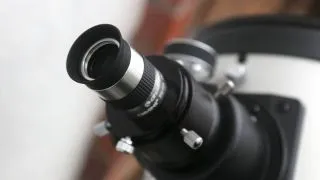 Celestron Starsense explorer 8-inch dobsonian star watching telescope close up view of eyepiece
Celestron Starsense explorer 8-inch dobsonian star watching telescope close up view of eyepiece
Telescope eyepieces can be swapped to adjust the magnification of a star watching telescope. Pictured is the eyepiece from the Celestron Starsense explorer 8-inch dobsonian. (Image credit: Jamie Carter)
Magnification: How do star watching telescope eyepieces work?
Eyepieces function by magnifying the light that has been focused by the telescope’s primary mirror or objective lens. Every telescope eyepiece has a specific focal length (measured in millimeters), and a shorter focal length results in higher magnification. To determine the magnification provided by any particular eyepiece on a star watching telescope, divide the telescope’s focal length by the focal length of the eyepiece being used. For example, a 1000mm focal length telescope (such as a 100mm refractor with an f/10 ratio, or a 200mm Newtonian with an f/5 ratio) will provide a magnification of 100x when used with a 10mm eyepiece (1000 divided by 10 = 100).
While any star watching telescope can achieve impressively high magnifications using eyepieces with short focal lengths, there is a point at which increasing magnification will degrade the image rather than improve it. When an object is magnified, its brightness is reduced as the fixed amount of collected light is spread over a larger area. Additionally, increasing magnification exacerbates the visibility of atmospheric turbulence; therefore, high magnifications are only practical when ‘seeing’ conditions are excellent. Finally, high magnification is most practical with driven telescopes; otherwise, the object will quickly drift out of the narrow field of view, interrupting your star watching.
As a general guideline, your highest power eyepiece should provide a magnification approximately double the telescope’s aperture in millimeters – for example, 200x on a 100mm telescope, 400x on a 200mm telescope, and so on.
It’s generally advisable to have at least three high-quality eyepieces for your star watching telescope that offer low, medium, and high magnifications – perhaps around 50x, 100x, and 200x. Taking a 100mm f/10 telescope as an example, suitable eyepieces would have focal lengths of approximately 20mm, 10mm, and 5mm. Assuming these are commonly used Plossl eyepieces, the 20mm eyepiece would provide a field of view around one degree across (an area of 0.8 square degrees) – ideal for sweeping the deep skies and finding objects. The 10mm eyepiece would roughly frame the half-degree diameter moon and have a field covering just one-quarter that of the 20mm eyepiece. With its high magnification, the 5mm eyepiece would have a field of view covering only one-sixteenth that of the 20mm eyepiece and should only be used when seeing conditions are stable enough to support this level of detail for your star watching.
Update Log
Recent updates
*Editor’s note 05/08/2025***: Updated introduction to include details of the May 12 full moon, colorful stars in the night sky (Summer Triangle, Arcturus, Antares), and Saturn’s appearance, enhancing the context for using a star watching telescope**.
How We Test Star Watching Telescopes
To ensure you receive honest reviews and informed recommendations for the best star watching telescopes, each model is thoroughly tested and used for observation to evaluate its performance in all aspects.
We examine the construction of the Optical Tube Assembly (OTA) to provide readers with a clear breakdown. This includes discussing the telescope type (refractor, reflector, catadioptric), the number of OTA components, the size of the OTA, and the clarity of the optics (lens or mirror). This is important because some telescopes require advanced collimation (alignment) of the mirrors and consistent cleaning to ensure they perform optimally for star watching.
Telescope accessories, such as eyepieces and mounts, are assessed based on their functionality and quality. Alt-azimuth and equatorial mounts are tested for smooth movement, particularly if they are motorized. Star alignment is another critical feature we evaluate, as techniques can range from aligning a simple finderscope to advanced laser collimation methods. We consider how user-friendly these processes are for setting up the star watching telescope.
Given that telescopes are complex optical instruments, we evaluate the level of astronomical knowledge a user would need to operate the telescope comfortably. Powerful, intricate telescopes often require regular collimation, and movement can misalign mirrors, necessitating adjustment before each observation session. Our recommendations also consider whether the star watching telescope is portable and suitable for traveling to dark-sky sites.
The most crucial part of testing a star watching telescope is assessing its observational capabilities. We provide examples of the objects we attempted to observe and honestly describe the quality of the image, noting any aberrations or distortions. Across a range of telescopes, our reviewers have observed the moon, Jupiter, and various Messier objects, checking for optical flaws.
To provide you with reviews you can trust, we compare the claims made by telescope manufacturers against real-world usage. Our staff and freelance reviewers are seasoned stargazers with extensive experience using telescopes. We also collaborate with astronomy experts to ensure the information we provide on star watching telescope usage is accurate and valuable.
Contributing Experts
Star watching telescope FAQ answered by
Dr Gemma Lavender
A contributing expert to Space.com, Live Science, All About Space and more, Gemma is the author of several books including ‘Quantum Physics in Minutes’. She holds a degree in physical sciences, a Master’s in astrophysics and a PhD in computational astrophysics and became fellow of the Royal Astronomical Society in 2011. Gemma is also the Communications and Outreach Officer at the European Space Agency.
With contributions from
